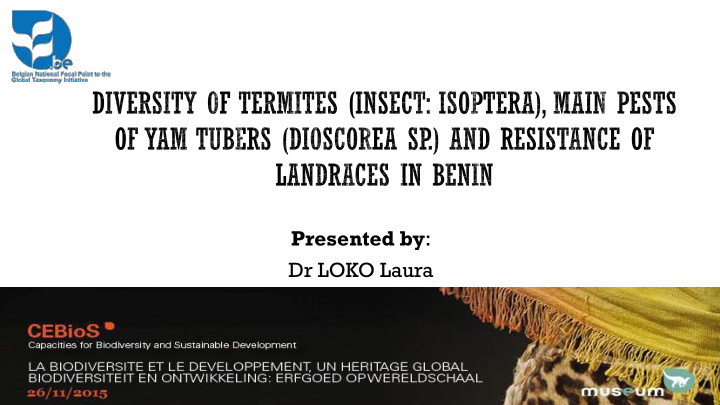



Presented by : Dr LOKO Laura
Economical importance Nutritional importance Sociocultural importance Figure 1 : Yam (Dioscorea spp.)
Background Non-producing zone Atacora zone Bariba zone Constraint : Impact of Constraint : Pest and climate change diseases Donga zone Central zone Constraint : Post-harvest conservation Constraint: Pest and soil infertility Non-producing zone (Loko et al., 2013a) Figure 2 : Map of Benin showing yam production zone
Background Termites have been reported as one of the most important causes of damage to yam tubers in Central and Northern Benin (Loko et al. 2013b). Losses due to termite attack are high and can reach more than 5 tonnes/ha (Atu 1993). a) External view b) internal view Figure 3 : Yam tuber attacked by termites
Background Given the antagonistic roles that termites can play, it is important to understand farmers’ perceptions of termites as pests Figure 4 : Termites mound destructed by farmers in yam field
14 villages selected based on the severity of termite problem in yam (Loko et al. 2013). Survey and sampling of termites in in 24 yam field were done Figure 4 : Map of Central Benin showing the geographical position of the surveyed villages
Amitermes evuncifer Trinevitermes oeconomus Macrotermes bellicosus Felluritermes tenebricus 45 vernacular names of termites recorded in the study area corresponded to ten species Macrotermes ivorensis Coptotermes sjostedti Macrotermes subhyalinus Trinevitermes geminatus Amitermes guineensis Trinevitermes togoensis Pericapritermes sp. Microcerotermes sp. Ancistrotermes cavithorax Figure 5: Diversity of yam termites pest
1.3 Petroleum Eight strategies to reduce losses 1.3 Sulfur due to termites were reported by 4 Clean weeding surveyed farmers (32.5%). 5.3 Salt 7.9 Queen removal Synthetic insecticides, especially 9.2 Botanical extracts those used for the protection of 34.2 Destruction of termites nest cotton, such as Cotofan 350EC and Thionex 350EC with the active 36.8 Synthetic insecticides ingredient endosulfan. 0 10 20 30 40 Percentage of responses Figure 6 : Farmers’ management practices for the control of termites
Table 4 : Yam landraces identified by farmers as tolerant to termites (n=73) Tolerant landraces Importance (No. of farmers) % of respondents Irindou 24 32.8 Karatchi 15 20.5 Gnidou 12 16.4 Throughout the study zone, 12 yam Alakitcha 9 12.3 landraces were listed by farmers Kangni 6 8.2 as tolerant to termite attack. Tchemélé 1 1.4 Takpadou 1 1.4 Kpété 1 1.4 Kpakata 1 1.4 Kadjeme 1 1.4 Effourou 1 1.4 Kadjim 1 1.4
Remaining activities Identify termites diversity existing in yam field situated in northern Benin Identify resistant/ tolerant yam cultivars to termite attacks produced in Benin through participatory evaluation with farmers. Characterize the identified cultivars using microsatellite molecular markers to determine the possible synonymies. Assess the resistance of the identified cultivars vis-à-vis of termites for the establishment of a pool of varieties can be used by research (breeding) and development (varietal exchange and introduction). Sensitization of farmers on the positive act of termite on soil fertilization
THANKS FOR YOUR ATTENTION
Recommend
More recommend